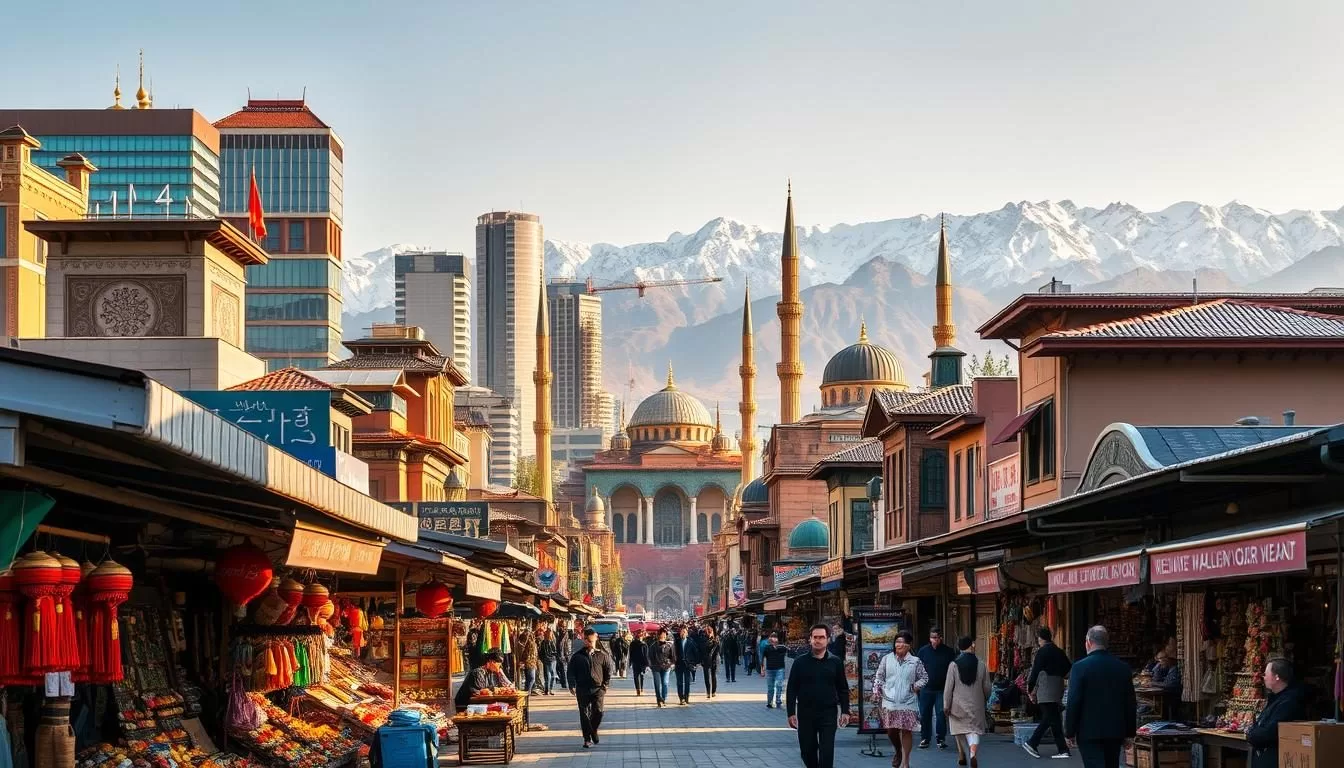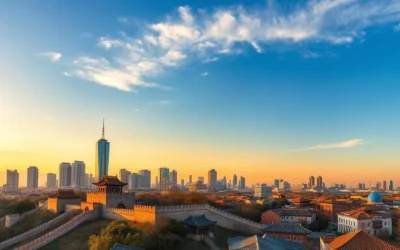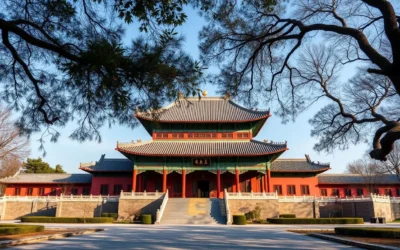✓ Accommodations✓ Flights✓ Rental Cars
Exploring the linguistic landscape of a vast area reveals fascinating insights into its culture and history. This region, home to over 25 million people, boasts a rich tapestry of languages and dialects. Among them, one stands out as a cornerstone of identity and communication.
With a population density of just 16 people per square kilometer, this area is as diverse in its people as it is in its geography. Over 44 languages are spoken here, reflecting the unique blend of ethnic groups that call this place home.
The primary language, used by millions, is a vital part of daily life. It is supported by a modified script and is widely used in education, media, and government. This language connects communities and preserves traditions.
Understanding these linguistic features helps you appreciate the cultural richness of this region. It’s a journey into the heart of its identity and a testament to its enduring legacy.
Overview of Xinjiang’s Linguistic Landscape
The linguistic diversity of this area offers a unique window into its cultural richness and historical depth. Over 44 languages are spoken here, reflecting the vibrant mix of ethnic groups that call this place home.
This region is a melting pot of cultures, where multiple languages coexist harmoniously. The primary languages, used by millions, play a vital role in daily life, education, and governance.
Bilingual education policies have shaped the way people communicate. Schools teach in both the dominant language and local dialects, ensuring students gain access to a broader world.
Historical ties with Central Asia have left a lasting impact on the linguistic landscape. These influences are evident in the scripts and dialects used across the area.
Modern technology also plays a role. Translation tools and digital resources support language learning, making it easier for people to connect across linguistic barriers.
Here are some key aspects of this dynamic language ecosystem:
- Coexistence of Languages: Multiple languages thrive side by side, enriching the cultural fabric.
- Bilingual Education: Schools emphasize learning in both primary and secondary languages.
- Historical Influences: Central Asian ties have shaped dialects and scripts over centuries.
- Technological Support: Digital tools aid in language learning and communication.
This blend of tradition and innovation creates a vibrant linguistic environment. It’s a testament to the resilience and adaptability of the people in this region.
Historical Context of Language Diversity in Xinjiang
Languages in this region carry stories of ancient civilizations and modern transformations. The area’s linguistic roots stretch back thousands of years, shaped by migrations, trade, and cultural exchanges. From early Turkic dialects to modern alphabets, the journey of language here is a testament to its rich heritage.
Ancient Roots and Early Cultures
The earliest languages in this area were part of the Turkic family, spoken by nomadic groups. Inscriptions and artifacts reveal the use of runic scripts, which evolved over time. The Silk Road played a key role, connecting this region to Central Asia and beyond, fostering linguistic diversity.
By the 9th century, Old Uyghur emerged as a prominent language. It was used in religious texts and administrative records, leaving a lasting impact on the region’s cultural identity.
Modern Evolution Through the Centuries
Over the centuries, languages here adapted to new influences. The Chagatai language, a branch of Turkic, became widely used in literature and governance. By the 19th century, the region saw the introduction of modern alphabets, blending local scripts with external innovations.
Today, the linguistic landscape reflects both ancient traditions and modern developments. Bilingual education and digital tools help preserve and promote these languages, ensuring their survival for future generations.
| Period | Key Developments |
|---|---|
| Ancient Times | Turkic languages and runic scripts dominate. |
| 9th Century | Old Uyghur emerges as a major language. |
| 13th-19th Century | Chagatai language flourishes in literature and governance. |
| Modern Era | Modern alphabets and bilingual education take root. |
Understanding this historical context helps you appreciate the depth of linguistic diversity in the region. It’s a story of resilience, adaptation, and cultural pride.
Cultural and Political Influences on Xinjiang Languages
Cultural exchanges along ancient trade routes left a lasting linguistic legacy. The Silk Road was not just a pathway for goods but also a bridge for ideas, scripts, and dialects. This exchange enriched the region’s linguistic diversity, introducing new ways of communication and cultural expression.
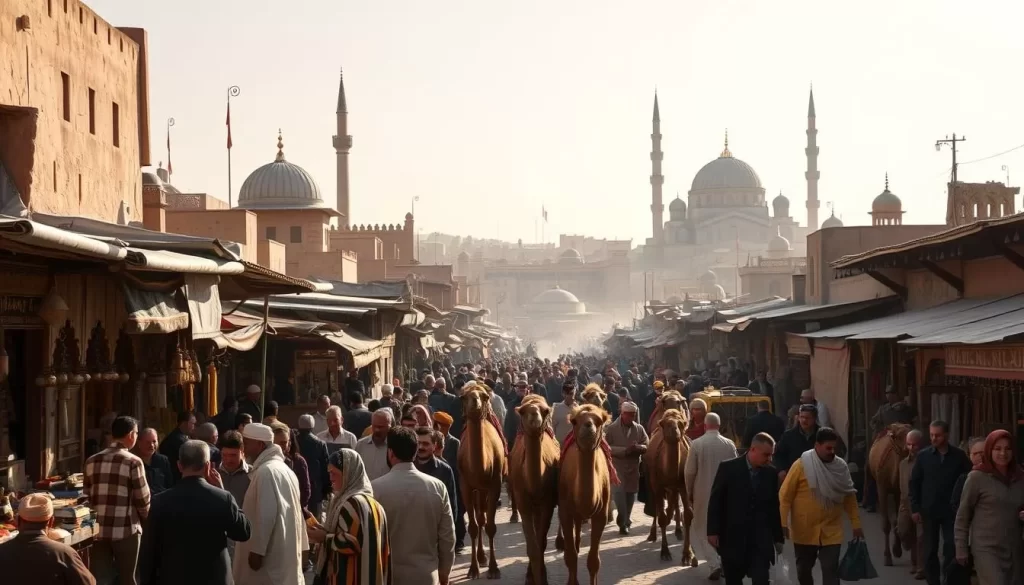
Silk Road Legacy and Exchange
The Silk Road connected this area to Central Asia and beyond, fostering a vibrant mix of languages. Merchants, scholars, and travelers brought with them unique scripts and dialects, which blended with local traditions. This interaction created a rich tapestry of linguistic heritage that still influences the region today.
Over time, these exchanges shaped the way people communicated. The introduction of new alphabets and writing systems transformed education and governance. This legacy is evident in the diverse scripts used across the area, reflecting centuries of cultural interaction.
Political Transformations and Governance
Political changes have also played a key role in shaping language policies. Modern governance has introduced initiatives to standardize education and promote bilingual systems. These efforts aim to balance cultural preservation with national integration.
Government policies have influenced how languages are taught and used. For example, bilingual education programs ensure students learn both local dialects and the dominant language. This approach supports cultural identity while preparing individuals for broader opportunities.
Active political oversight continues to impact language use. Policies are designed to maintain harmony while addressing the needs of diverse communities. This balance is crucial for preserving linguistic diversity in a rapidly changing world.
Understanding Xinjiang Uygur Autonomous Region, China: Official and widely spoken languages
The official languages of this region are more than just tools for communication—they are symbols of cultural identity. These languages connect communities, preserve traditions, and reflect the area’s rich heritage.
One of the primary languages, the Uyghur language, holds a special place in daily life. It is widely used in education, media, and governance, ensuring its continued relevance. Traditional scripts, such as the Perso-Arabic alphabet, are celebrated in schools and media, keeping the cultural legacy alive.
The interplay between language and identity is profound here. Policies support bilingual education, allowing students to learn both the dominant language and local dialects. This approach fosters cultural pride while preparing individuals for broader opportunities.
Language also plays a key role in public life. From government documents to media broadcasts, the use of official languages reinforces cultural heritage. This dynamic relationship between language and policy shapes the region’s unique identity.
“Language is the road map of a culture. It tells you where its people come from and where they are going.”
With a population of over 26 million, this region’s linguistic diversity is a testament to its cultural richness. Understanding these languages offers a deeper appreciation of its history and the resilience of its people.
The Role of the Uyghur Language
The Uyghur language stands as a pillar of cultural identity and communication in its region. Its unique script and dialects reflect centuries of history and adaptation. This language is not just a means of communication but a symbol of resilience and heritage.
Script, Orthography, and Writing Systems
The Uyghur script has evolved over time, influenced by various systems. Originally written in the Perso-Arabic alphabet, it later adapted Cyrillic and Latin scripts. These changes reflect historical shifts and cultural exchanges.
Today, the Perso-Arabic script is widely used, preserving the language’s traditional roots. This alphabet is a key part of education and media, ensuring its continued relevance.
Dialects and Linguistic Variations
The Uyghur language boasts a rich diversity of dialects. These variations are shaped by geography and history, creating a vibrant linguistic landscape. Each branch of the language carries unique expressions and cultural nuances.
From daily conversations to artistic expressions, these dialects play a vital role in shaping regional identity. They connect communities and preserve traditions, making the language a living testament to its people’s heritage.
The Impact of Chinese Government Policies on Language
Government initiatives play a crucial role in shaping linguistic practices. In this region, policies aim to balance cultural diversity with national unity. One key focus is bilingual education, which integrates local dialects with Mandarin Chinese.
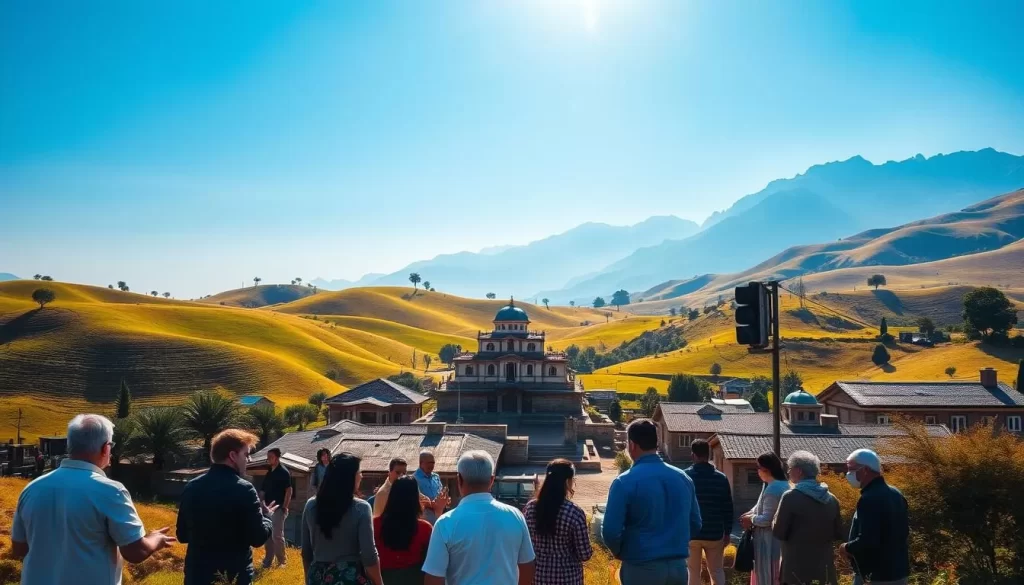
These policies have a significant impact on curriculum design, especially in STEM subjects. Students are required to learn both languages, ensuring they are prepared for broader opportunities. However, this dual focus can pose challenges for learners.
Bilingual Education Initiatives
Bilingual education programs are designed to promote cultural preservation while fostering national integration. Schools teach in both Mandarin and local dialects, ensuring students gain access to a wider world. This approach supports cultural identity while preparing individuals for future success.
Despite these goals, some students face difficulties adapting to language differences. For example, studies show that after taking minority language classes, many students struggle to master the basics. This highlights the need for better teacher training and resources.
“Language is not just a tool for communication; it is a bridge to understanding and unity.”
Here’s a breakdown of how these policies affect education:
| Aspect | Impact |
|---|---|
| Curriculum Design | STEM subjects are taught in both languages, ensuring comprehensive learning. |
| Student Adaptation | Some students face challenges in mastering both languages effectively. |
| Cultural Preservation | Local dialects are integrated into education, preserving heritage. |
| National Integration | Mandarin is emphasized to promote unity and broader opportunities. |
These initiatives aim to create a harmonious balance between cultural diversity and national cohesion. While they face challenges, they remain a vital part of the region’s educational framework.
Education and Language in the Region
Education in this diverse region blends language learning with academic growth, creating unique opportunities and challenges. Bilingual programs integrate local dialects with Mandarin, ensuring students gain access to broader opportunities. However, this dual focus can present hurdles, especially in STEM subjects.
Challenges in STEM and Language Learning
Differences in grammar and word order between dialects and Mandarin can complicate STEM education. For example, students may struggle to grasp complex concepts when instruction switches between languages. This highlights the need for tailored teaching methods to bridge these gaps.
Here’s how bilingual education impacts learning:
- Curriculum Design: STEM subjects are taught in both languages, ensuring comprehensive understanding.
- Student Adaptation: Some students face difficulties mastering both languages effectively.
- Teaching Methods: Educators adapt strategies to support diverse learning needs.
Despite these challenges, bilingual programs aim to preserve cultural identity while preparing students for future success. The education system continues to evolve, addressing these obstacles through innovative policies and resources.
“Education is the most powerful weapon which you can use to change the world.”
Supporting both language and academic excellence is crucial for the region’s future. By addressing these challenges, schools can empower students to thrive in a globalized world.
Media, Literature, and the Preservation of Language
Media and literature serve as powerful tools in preserving cultural heritage and language. They bridge the gap between generations, ensuring that traditions and linguistic identity remain alive. Through newspapers, books, and digital platforms, the essence of a language is passed down, enriching the cultural fabric of a region.
Traditional Literary Works and Modern Publications
Traditional literary works, such as poetry and historical texts, play a vital role in keeping a language vibrant. These works often reflect the values and stories of a community, offering a glimpse into its past. Modern publications, on the other hand, adapt these traditions to contemporary contexts, making them accessible to younger audiences.
Over 80 newspapers and magazines, along with multiple TV channels, contribute to this effort. They use both old and new scripts, ensuring that the language evolves while staying rooted in its heritage. Renowned publications often blend historical content with modern perspectives, creating a dynamic mix that appeals to diverse readers.
Books, audio products, and e-publications also play a crucial role. They reinforce language learning among younger generations, making it easier for them to connect with their cultural roots. This ongoing work reflects the continuous evolution of a language in a changing world.
“Literature is the art of discovering something extraordinary about ordinary people and saying with ordinary words something extraordinary.”
Media organizations and community groups are at the forefront of this effort. They ensure that the language remains a living, breathing part of daily life. By supporting both traditional and modern forms of expression, they help preserve the unique identity of a region.
Linguistic Demographics and Population Trends
Understanding population trends and language use offers a deeper look into the cultural fabric of this area. With over 25 million residents, the region is a vibrant mix of ethnic groups, each contributing to its linguistic diversity.
The population has grown significantly since 1949, reaching 25.85 million by 2020. This growth reflects a compound annual rate of 1.71%, higher than the national average. Such changes have shaped how languages are used and preserved across urban and rural areas.
Ethnic minorities make up a substantial portion of the population, totaling 14.93 million in 2020. This diversity is evident in the number of languages spoken, which are deeply intertwined with cultural identity. For example, the Uyghur population grew at a rate of 1.67% in the first two decades of the 21st century, highlighting its resilience.
Urbanization also plays a role. In 2020, 56.53% of the population lived in cities, while 43.47% resided in rural areas. This shift influences language use, as urban centers often adopt dominant languages for broader communication.
Demographic data is crucial for shaping language policies. For instance, bilingual education programs aim to balance cultural preservation with national integration. These initiatives ensure that both local dialects and dominant languages thrive.
Uyghur and Minority Languages: Coexistence and Diversity
The harmony of languages in this area reflects a deep cultural connection. Here, the Uyghur language coexists with other minority dialects, creating a vibrant linguistic tapestry. This interaction is a testament to the region’s rich heritage and mutual respect among communities.
Ethnic balance plays a key role in fostering this linguistic harmony. Each group contributes to the cultural fabric, ensuring that no dialect is left behind. This balance is maintained through community-based initiatives that celebrate diversity.
Ethnic Balance and Linguistic Interaction
In this region, languages interact in ways that enrich daily life. For example, bilingual education programs ensure that students learn both the dominant and local dialects. This approach fosters understanding and unity among different ethnic groups.
Community events also play a vital role. Festivals and cultural gatherings provide a platform for people to share their traditions. These interactions strengthen bonds and promote mutual respect.
Here are some examples of how linguistic coexistence is achieved:
- Bilingual Education: Schools teach in multiple languages, ensuring students are fluent in both local and dominant dialects.
- Cultural Festivals: Events celebrate the unique traditions of each ethnic group, fostering unity.
- Community Initiatives: Local organizations work to preserve and promote minority languages.
This dynamic process of linguistic interaction is integral to multicultural communities. It ensures that every person feels valued and connected to their heritage. For more insights into how cultural policies shape language use, visit this detailed report.
“Language is the road map of a culture. It tells you where its people come from and where they are going.”
In a world where many languages are at risk, this region stands as a beacon of linguistic diversity. Its commitment to preserving and celebrating dialects ensures a brighter future for generations to come.
Script Systems and Writing Innovations in Xinjiang
The evolution of script systems in this area highlights a fascinating blend of tradition and innovation. Over time, the region has seen the use of Perso-Arabic, Cyrillic, and Latin scripts, each contributing to its linguistic richness. These systems reflect both historical legacy and modern advancements, creating a dynamic language landscape.
Perso-Arabic, Cyrillic, and Latin Scripts
The Perso-Arabic script remains the dominant writing system in this region. It is widely used in education, media, and governance, ensuring its continued relevance. This alphabet preserves traditional roots while adapting to modern needs, making it a cornerstone of cultural identity.
Cyrillic and Latin scripts also play important roles. While not as prevalent, they serve auxiliary purposes, especially in digital communication and technology. These adaptations showcase the region’s ability to balance tradition with innovation.
Here’s a breakdown of how these scripts are used:
| Script | Primary Use |
|---|---|
| Perso-Arabic | Official documents, education, and media. |
| Cyrillic | Historical texts and digital communication. |
| Latin | Modern technology and international outreach. |
Writing innovations have bridged traditional practices with modern tools. For example, digital platforms now support multiple scripts, making it easier for people to connect across linguistic barriers. This blend of old and new ensures that the region’s language heritage remains vibrant and accessible.
Experimentation with script systems is part of ongoing efforts to modernize language usage. These initiatives reflect the region’s commitment to preserving its cultural identity while embracing global advancements. For more insights into how these efforts shape linguistic practices, explore this detailed analysis.
Global Impact and Diaspora of Xinjiang Languages
The influence of Xinjiang’s languages extends far beyond its borders, shaping global communities and cultural exchanges. Significant Uyghur-speaking communities now thrive in countries like Kazakhstan, Kyrgyzstan, Turkey, and the United States. These diasporic groups play a vital role in preserving and adapting their linguistic traditions.
Cultural and linguistic exchanges are taking place on the world stage. These communities help maintain a connection to their heritage while integrating into new societies. For example, Uyghur cultural associations abroad organize events that celebrate traditional music, dance, and literature.
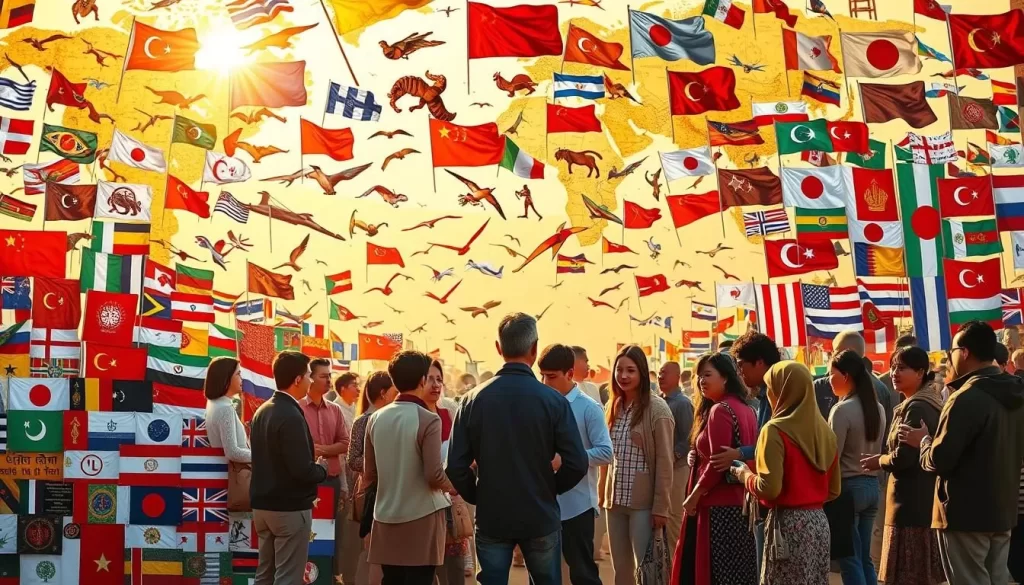
Global migration has a profound impact on language use and identity. As people move, they carry their dialects and traditions with them. This creates a dynamic interplay between preserving heritage and adapting to new environments.
Here’s a breakdown of how diasporic communities contribute to linguistic preservation:
| Country | Community Role |
|---|---|
| Kazakhstan | Organizes cultural festivals and language classes. |
| Turkey | Publishes books and media in Uyghur dialects. |
| United States | Supports educational programs for younger generations. |
Community organizations abroad are at the forefront of these efforts. They ensure that the language remains a living part of daily life, even in foreign lands. For more insights into the global diaspora of Uyghurs, visit this detailed report.
“Language is the road map of a culture. It tells you where its people come from and where they are going.”
This global network of communities ensures that the language and culture of this region continue to thrive. It’s a testament to the resilience and adaptability of its people in a changing world.
Modern Developments: Digital Tools and Language Translation
Digital advancements are transforming how we communicate and preserve languages in today’s world. From translation apps to online platforms, technology is making it easier to bridge linguistic gaps and support cultural heritage.
Google Translate and Technological Integration
Since February 2020, Google Translate has supported Uyghur, making it more accessible globally. This integration has been a game-changer for digital communication and language preservation efforts.
With over 108 languages now supported, Google Translate is a powerful tool for breaking down barriers. It uses advanced machine learning to improve accuracy and accessibility, helping millions connect across linguistic divides.
Digital tools are also reshaping education. Apps and platforms now support bilingual learning, allowing students to study in both their native and dominant languages. This approach fosters cultural pride while preparing them for global opportunities.
However, challenges remain. While technology makes language learning more accessible, it can also dilute traditional practices. Balancing innovation with cultural preservation is key to ensuring these tools benefit everyone.
“Technology is best when it brings people together.”
Here’s how digital tools are making an impact:
- Accessibility: Translation apps like Google Translate make language learning and communication easier for everyone.
- Education: Bilingual platforms support students in mastering multiple languages.
- Preservation: Digital archives help protect endangered dialects and scripts.
For more insights into how Google Translate is expanding its capabilities, visit this detailed article.
As technology continues to evolve, its role in language preservation and education will only grow. Embracing these tools while respecting cultural traditions ensures a brighter future for linguistic diversity.
Challenges Facing Language Preservation
The struggle to maintain linguistic heritage highlights the tension between cultural identity and modernization. In many areas, traditional languages face significant threats from external pressures, including political policies and cultural assimilation.
One major challenge is the shift in educational systems. For example, in some regions, schools have transitioned to using dominant languages for instruction, leaving minority dialects at risk. This shift often conflicts with community efforts to preserve their linguistic heritage.
Government initiatives sometimes prioritize national integration over cultural diversity. While bilingual education programs aim to balance these goals, they can inadvertently marginalize minority languages. This creates a complex dynamic where policies intended to unify may instead erode cultural identity.
Identity and language rights are central to current debates on cultural preservation. Many communities view their dialects as a vital part of their heritage. When these languages are threatened, it can lead to broader concerns about cultural erasure.
“Language is not just a tool for communication; it is a bridge to understanding and unity.”
Addressing these challenges is critical for sustaining cultural diversity. Efforts to protect traditional languages must balance modern needs with historical significance. For more insights into how these issues are being addressed, visit this detailed report.
Future Prospects for Linguistic Diversity in Xinjiang
The future of linguistic diversity in this area looks promising, with evolving technology and community efforts paving the way. Innovations in education and digital tools are set to play a key role in preserving and enhancing the rich tapestry of languages spoken here.
One of the most exciting developments is the expansion of bilingual education programs. These initiatives aim to balance cultural preservation with national integration, ensuring students are fluent in both local dialects and dominant languages. This approach not only supports cultural identity but also prepares individuals for broader opportunities.
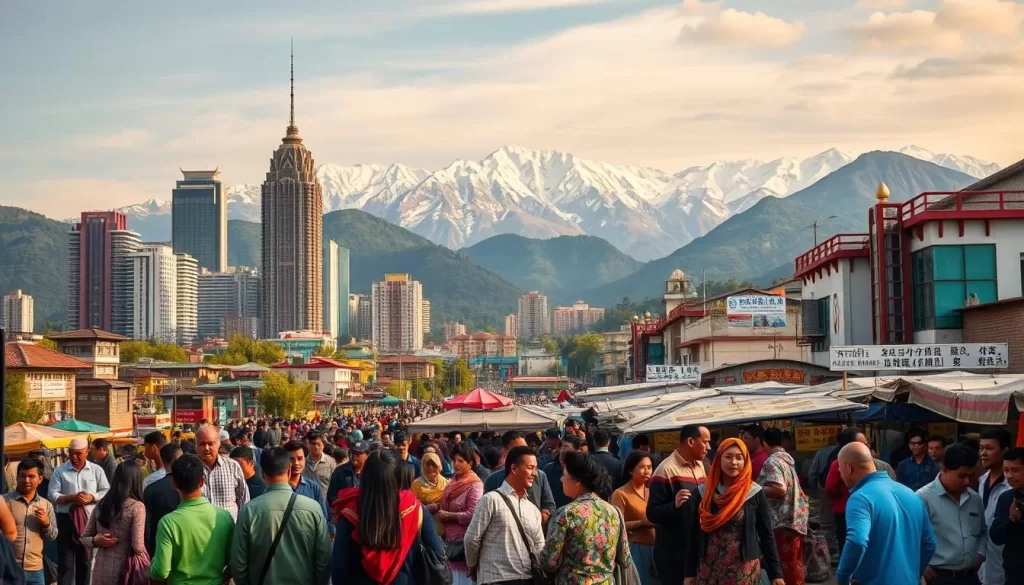
Technological advancements are also making a significant impact. Tools like Google Translate now support Uyghur, making it easier for people to connect across linguistic barriers. Digital platforms are also being used to teach languages, ensuring younger generations stay connected to their heritage.
Community initiatives are another bright spot. Local organizations are working tirelessly to preserve and promote minority languages. Festivals, cultural events, and educational programs are helping to keep these dialects alive.
Here’s a breakdown of the key factors shaping the future of linguistic diversity:
| Factor | Impact |
|---|---|
| Bilingual Education | Supports cultural identity and prepares students for global opportunities. |
| Technological Tools | Makes language learning and communication more accessible. |
| Community Initiatives | Preserves and promotes minority languages through events and education. |
For more insights into how these efforts are shaping the future, visit this detailed report.
“The future belongs to those who prepare for it today.”
As we look ahead, it’s clear that the combination of technology, education, and community efforts offers hope for the preservation of linguistic diversity. These initiatives ensure that the rich cultural heritage of this region continues to thrive for generations to come.
Conclusion
The rich tapestry of languages in this area reflects its cultural depth and historical resilience. Over centuries, diverse dialects have evolved, shaped by migration, trade, and political changes. Today, this linguistic heritage faces modern challenges, yet remains a vital part of cultural identity.
Technological advancements and educational initiatives play a crucial role in preserving these languages. Digital tools and bilingual programs ensure that younger generations stay connected to their roots. These efforts bridge the gap between tradition and modernity, fostering pride and continuity.
Looking ahead, the future of linguistic diversity in this region is promising. Community-driven projects and global outreach continue to celebrate and protect these dialects. By understanding and valuing this heritage, we ensure it thrives for generations to come.
The above is subject to change.
Check back often to TRAVEL.COM for the latest travel tips and deals.
